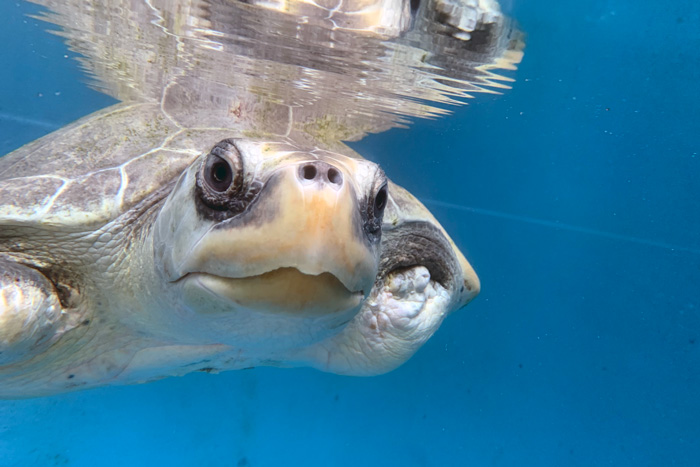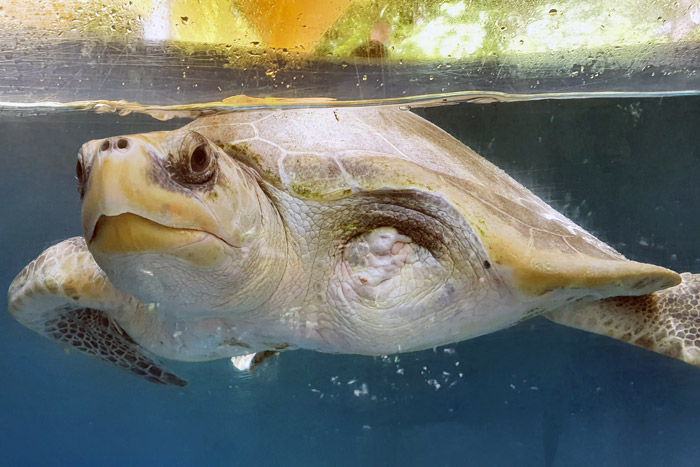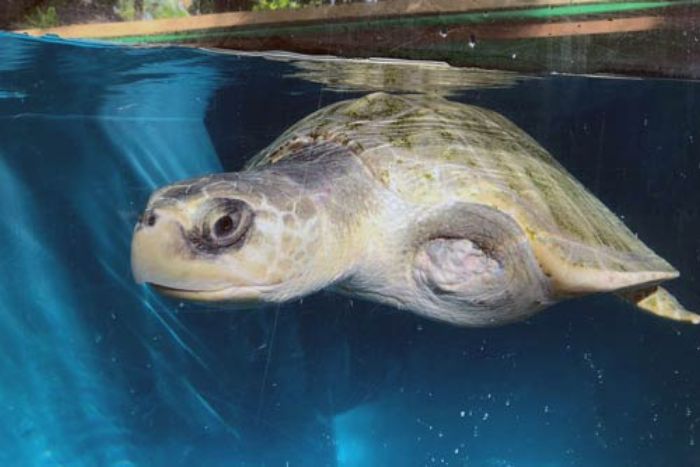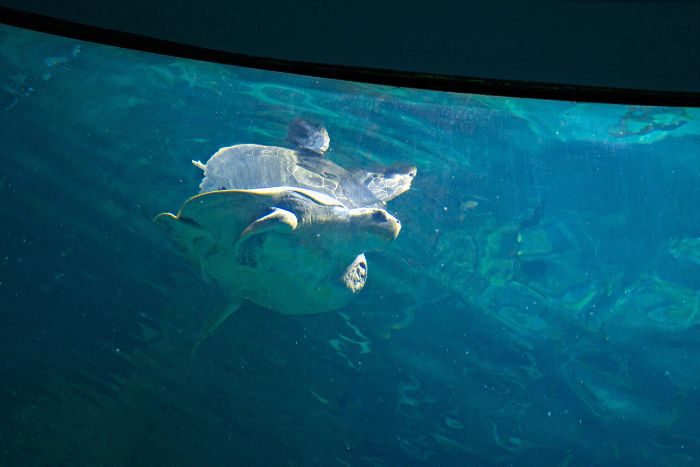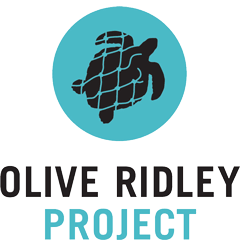Heidi’s story
Heidi was an adult male olive ridley sea turtle who was admitted to the Marine Turtle Rescue Centre in April 2018. He was rescued from South Malé Atoll with deep entanglement injuries to both of his front flippers.
Heidi achieved celebrity status in the four and a half years he was with us. Thanks to his cheeky personality, he gained many followers and adoptive parents over the years.
Heidi’s medical history
When Heidi arrived in 2018, he had deep entanglement wounds to his two front flippers with bone exposure. Since he could move his flippers well, we treated his wounds and believed that both flippers would heal. However, his left front flipper began to show signs of deterioration and in May 2018, this flipper had to be amputated since it lost all blood supply and sensation.
Heidi recovered well from his surgery and swam fine with just 3 flippers. But soon after, Heidi’s use of his right front flipper was reduced, which indicated that the entanglement wounds had healed in a way that hampered the flipper’s movement. In addition to this, his X-rays showed a bone infection in the right shoulder. Both of these afflictions together reduced Heidi’s chance at using this flipper normally. As feared, the flipper eventually stopped showing any movement at all. This essentially left Heidi with only two functional flippers – both at the back.
Was Heidi a male or female turtle?
When Heidi arrived at the Rescue Centre, he was 65 cm long and didn’t have much of a tail. This led us to assume that Heidi was a girl. However, over time, the tail grew an unusual amount for a female turtle and it was confirmed by ultrasound that Heidi was in fact a boy!
Quick tip: You can tell the sex of a sea turtle by looking at their tail. Male turtles, after reaching sexual maturity, will develop long tails, which may even extend past the hind flippers. Female turtles on the other hand, have a short tail, which generally doesn’t extend more than 10 cm (four inches) past the edge of the carapace (shell).
What was Heidi’s personality like?
Heidi’s most well known trait was his stellar appetite! Once he was back to full health, he never missed a meal. His mobility in water was equally impressive, despite his lack of working front flippers. He would often do full back flips and barrel rolls to grab food, delighting everyone. We never found anything he wouldn’t eat, be it crabs, fish innards or barnacles, and he once even tried to bite a waterhen that landed on the surface of his tank (no harm came to that waterhen).
As with any wild animal, Heidi did not enjoy being handled, but he was always very tolerant of clinical procedures. In fact, such was his demeanour that he was once even a blood donor for a critically ill patient who needed a blood transfusion to fix life threatening anaemia.
Above all, Heidi has been a true advocate of the resilience of sea turtles and by being such an engaging patient, he has allowed our Rescue Centre team to teach many guests and visitors about the plight of sea turtles and the dangers of ghost gear in particular.
Why was Heidi not released in the wild?
Although Heidi still had one front flipper, it has no functionality due to the damage caused by ghost gear entanglement – effectively this means he was a double amputee. This gave him very little chance of survival in the wild because he could not turn easily, navigate currents or adverse weather, and he would not be able to avoid predators in the wild. However, because he was able to dive and swim well (expressing normal natural sea turtle behaviour), we thought he will do very well in the more controlled environment of an aquarium, where he would have a lot more space to navigate, but none of the risks that would be present to him in the wild.
Three-flippered sea turtles: Sea turtles can survive in the wild with only three flippers as many sporadic sightings of turtles with such injuries show – they learn to adapt to a missing limb just like humans. For example, if they are missing a front flipper, they learn to compensate by using their opposite back flipper when swimming.
How difficult was it to find Heidi a new home?
It took us many years to successfully find somewhere for Heidi to move to – with involvement from our vets, Coco Palm Dhuni Kolhu guests and former ORP volunteers, all of whom suggested places that may be able to accommodate Heidi. After many rejections and multiple dead-ends, the team heard about the National Marine Aquarium (NMA) in Plymouth.
We reached out to the director of conservation and made a case for the lovely Heidi. With their strong focus on education and conservation, and the sad passing of their former elderly resident sea turtle, the NMA was perfectly placed to offer Heidi a forever- home.
However, that was only the first hurdle. After that, there was a remarkable amount of paperwork to complete. To move an endangered species between countries, both countries need a permit (one to export, the other to import) from the Convention of International Trade of Endangered Species of Fauna and Flora (CITES) but this isn’t as simple as it sounds!
Once the permits were finally in place we had to arrange to move Heidi – you can’t just book a seat on a plane for a turtle. Luckily British Airways and Trans Maldivian Airways came to Heidi’s rescue and kindly transported him as a VIP guest (free of charge).
In addition, Coco Palm Dhuni Kolhu’s wonderful carpentry team fashioned him his own travelling crate to fly in style. Our veterinary and management team worked extremely hard over many months to finalise the transfer details with the help of the team at the NMA.
The decision to transfer Heidi at that time was based on sound clinical and ethical foundations, and we explored every possible aspect of the transfer during our due diligence. Heidi displayed a stable clinical status for many months prior to the transfer, which included evaluation by serial radiographs, physical examinations, and blood-work.
What was Heidi’s life like at the aquarium?
Heidi’s new tank was seven times bigger than his tank at the Marine Turtle Rescue Centre. He shared his new home with other marine species that he would have naturally come across in the wild. This was a much more natural environment for him. Heidi even had cleaner fish that kept his shell lovely and clean rather than having to be scrubbed every week. Natural surroundings in the tank, such as rocks and corals, reduce overall stress by keeping Heidi’s life enriched.
Initially, Heidi settled in well at his new home. However, after several months of treatment and care at the NMA, additional significant medical issues were diagnosed related to his entanglement in ghost gear. The NMA elected to make the very difficult decision to euthanise Heidi in May 2023 after it was determined that his osteomyelitis had returned and advanced to a point where it was no longer treatable. ORP leadership and the veterinary team were not part of the discussion or the decision to euthanise Heidi. We are grateful that the NMA’s team exhausted every option at their disposal to give Heidi a long-term home.
What we have learnt from Heidi
Heidi’s story has taught us all a great deal, and it is our position now that we would not elect to transfer a patient out of a country under nearly any circumstance. This is informed by the fact that:
- transport is exceedingly stressful even under the best of circumstances;
- permanent captivity always includes some degree of poor health and ill fitness of the animal; and
- if no therapy can offer the chance at return to the wild, then euthanasia ought to be employed as a final, last resort to end that patient’s suffering.
We also acknowledge that other clinicians and rescue centres around the world have divergent opinions on this matter, so we think it is important to outline our view of minimum standards for the transport and placement of a sea turtle to a facility outside of the country or one that requires travel of great distance.
The minimum standards are based on our experiences in transfers of this kind at other facilities and reflect generally accepted best-practices transport guidelines in wildlife medicine for the long-distance movement of any wild animal. These standards are:
Shipping facility
- Sea turtle is free from disease and clinically normal for a minimum of three months prior to travel. Animals with existing disease must have demonstrated non-progression and management of disease for three months prior to travel.
- Full medical workups must be performed to determine the above. These include physical and neurological examinations, radiographs, blood chemistries, CBC / PCV / TS, and behavioral assessment.
Receiving facility
- Facility must have full-time veterinary coverage with at least one veterinary surgeon with experience in sea turtle and marine animal medicine.
- Facility must have the capacity and expertise to perform regular (at least twice yearly) physical and neurological exams, radiographs, full bloodwork (chemistries / CBC / PCV / TS), and behavioral assessments.
- Facility must have capacity and expertise to perform emergency and critical care measures if needed.
Evaluation of same-sided, double amputee sea turtle patients
Like all sea turtle veterinary surgeons, our veterinary surgeons have been trained to consider a sea turtle patient missing both limbs on one side as a euthanasia case, exclusively. Over the past several months, we have reframed this position, based on information shared with veterinary colleagues in India.
These colleagues have experience releasing same-sided, double amputees back into the wild, and have demonstrated survival for over two years with underwater photography. After discussing these cases with our team, we recommended that each of these patients be considered on a case-by-case basis and that it is possible for some patients who are missing both limbs on one side to be successfully rehabilitated and returned to the wild.
We continue to maintain that patients missing both hind flippers are potentially acceptable release candidates, while patients missing both front flippers are euthanasia cases. It is important to continually assess the latest science and findings to inform our clinical decisions and this change in position reflects that assessment.
Heidi was one of our most widely loved patients, delighting almost everyone with his personality. We are grateful to his adopters, who continued to support him throughoout his care. Heidi meant a great deal to you, as he did to our team here at the Olive Ridley Project, but we take peace in knowing that he is no longer suffering.

